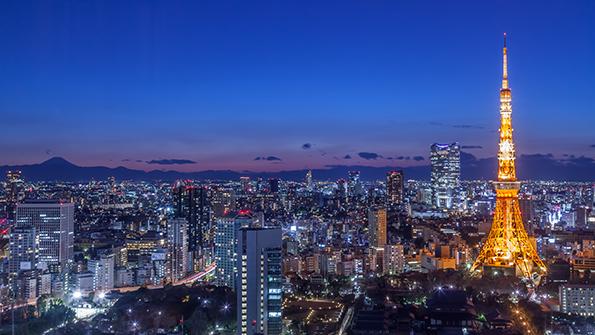
Many of Japan’s new space startups have settled amid the high-rise buildings of Tokyo.
Amid Tokyo’s neon-lit alleys and gleaming glass office buildings, Japan is nurturing a new space industry and a new generation of national champions.
Whereas in decades past the Japanese government might have looked to century-old corporate behemoths such as Mitsubishi Heavy Industries or NEC Corp. to provide a space industry, it now turns its favor toward entrepreneurs and venture capitalists.
- Japan relaxes emphasis on incremental improvements
- Government plays large role in boosting new space companies
- Automotive and electronics-makers look for opportunities off-planet
That has meant stomaching greater financial and social risks than Japan has traditionally accepted—and putting up a lot of government cash. But with the electrification of the automotive industry poised to upend its manufacturing base and ailing electronics giants such as Sony struggling to regain their footing, the country sees a need to jump-start a new industry and embrace disruptive innovation.
Disruptive innovation and its mantra of “move fast and break things” at first does not seem very Japanese. It is a country known, after all, for its social stability and for being one of the world’s best process innovators—a relentless practitioner and perfector of the discipline of lean manufacturing and its tenet of “kaizen,” or continuous improvement.
“We are good at improving something, for example, [1%] by year,” says Koji Ina, director of the Space Industry Office within Japan’s economy, trade and industry ministry (METI). “But for doing that, people need to do that same job for 20 or 30 years.”
However, in the rapidly emerging new space economy, there are no employees with 30 years’ experience in space junk removal, on-orbit manufacturing or lunar resource mining. Everyone, worldwide, is making it up as they go. And so by necessity Japan is trying to change the way it works.
University students, who might have once settled into the hierarchy and lifelong work as a “salaryman” at one of Japan’s large corporations, are warming up to the idea of employment at space startups, say Japanese space sector insiders. The success of venture-backed digital startups globally, but also in Japan, has made entrepreneurship more socially acceptable.
Japanese banks, known for being conservative in their lending practices, are testing the waters in the space sector. Venture capital investment in indigenous space companies over the past 10 years has surged from a single investment worth a negligible $200,000 in 2013 to $411 million across 14 companies in 2022, according to Pitchbook.
To be sure, the depth of investment in startups is nowhere near the scale within the U.S. space industry. However, the government does not want its country to have just a niche role. Japanese startups cover all segments of the space industry, including hyperspectral sensors, laser communications, low-Earth-orbit communications satellite constellations, in-space services, lunar resource mining and space robotics.
The Japanese government is boosting its industry in areas that it deems strategic. For example, METI has provided technology research and development funds to microsatellite manufacturer Axelspace and Earth-observation startup Synspective to develop a general purpose small-satellite bus that could be used for optical Earth observation, synthetic aperture radar and low-Earth-orbit missions. “We think the satellite bus is fundamental,” Ina says.
Axelspace and Synspective, alongside lunar lander builder Ispace, orbital debris removal service Astroscale and space robotics-maker Gitai, are hailed as Japan’s first generation of “new space” startups. Many of the companies have set up shop in the heart of Tokyo, tinkering with spacecraft in light industrial buildings nestled between high-rise apartments and office buildings.
The Japanese government, local investors and entrepreneurs say the country has homegrown advantages in the space sector. Startups are looking to the Japan Aerospace Exploration Agency (JAXA) and local universities as a source of intellectual property. The country’s large electronics and automotive industries offer commercial off-the-shelf parts that could be hardened and adapted for use in space. Manufacturing prowess behind production of some of the world’s most reliable, high-quality automobiles, composite materials, batteries, machine tools and robots also seems readily transferable to space.
Although Japanese electronics-makers such as Sony, Panasonic and Toshiba have struggled over the past 15 years as the digitization of electronics—like the introduction of the Apple iPhone—has negated the complex mechanical engineering and assembly processes in which Japanese industry excels, many see the space industry as offering new opportunities.
“We are expecting good synergy from those companies,” says Misuzu Onuki, executive vice president at Sparx Innovation for Future Co., a venture capital firm located across the street from Sony’s Tokyo headquarters.
Interest in space is coming from some surprising corners. For example, one of Ispace’s payload customers is automotive supplier NGK Spark Plugs of Nagoya, says Ispace Chief Financial Officer Jumpei Nozaki.
“Because the world is changing toward electric vehicles, the spark plug will no longer be used,” he says. “They have a strong sense that they need to make some new business to adapt to the world change.”
NGK Spark Plugs has developed an oxide-based ceramic electrolyte solid-state battery that it wants to test on the frigid surface of the Moon. At the Moon’s permanently shadowed poles, temperatures can sit at -240F—too cold for lithium-ion batteries, which have liquid electrolytes that would freeze. NGK Spark Plugs’ battery is en route to the lunar surface aboard Ispace’s Hakuto-R Mission 1, which launched Dec. 11.
Whereas space startups in the U.S. are heavily backed by independent venture capital firms, in Japan the government is playing a major role in getting the sector off the ground. In 2017, the government announced it wanted the country’s space industry to double in size, to about $21.1 billion by the early 2030s. It followed up a year later with a $960 million pool of funds for equity investments and loans. That fund is managed by the Development Bank of Japan and the Innovation Network Corp. of Japan (INCJ), a public-private investment fund.
The years before the government decision to invest in new space companies was “a really tight period,” says Shigeki Kuzuoka, president of the Satellite Business Network, a Japanese space consultancy. “These five years after support [began] from the Japanese government they are going really well.”
Government-backed enthusiasm for space has helped startups raise funds and overcome potential investor doubts. It took nearly two years for Ispace to raise its first round of capital, Nozaki says. “At that time, there was still just no real space business,” he says. “It was a true hurdle to convince businesses and to show that we have an actual business plan.”
In 2017, Ispace raised $90 million—its largest round of capital to date—in a Series A round led by INCJ and including the Development Bank of Japan, Suzuki Motor Corp. and Japan Airlines.
Many Japanese new-space companies have received an investment from INCJ. Corporate venture capitalist divisions, which are popular in Japan, and the country’s large banks frequently invest alongside INCJ.
“A lot of people in the big organizations in Japan feel threatened that if you cannot cowork with the [venture-backed startups], you are gone,” says Shin-Ichiro Kengaku, head of investment and research at Sparx. “That kind of pressure pushed them to establish corporate venture capital.”
Toyota Motor Corp., for example, is an investor in Sparx’s Space Frontier Fund, capitalized at about $61 million and launched in 2020 to invest in Japanese new space companies. “They needed knowledge and the connections in the space industry,” Shin says. “That’s the reason Toyota Motor Corp has decided to join our fund.”
While U.S. venture capital firms often obtain part of their funds from wealthy limited partners, Sparx deemed it inappropriate to solicit those types of potential investors without first establishing an investing track record. The Space Frontier Fund’s other investors include MUFG Bank, Sumitomo Mitsui Banking Corp. and Mizuho Bank.
Big automotive manufacturers are also dabbling in the new space sector. In 2020, Toyota and JAXA announced a project to develop the “Lunar Cruiser,” a crewed, pressurized lunar rover that is intended to be used as part of the NASA-led Artemis program. Honda is contracted to develop the lunar rover’s fuel cell.
Much of the Japanese space industry’s revenue still comes from JAXA. The space agency has been known to favor large, established Japanese corporations with a track record of success, such as IHI Aerospace, Mitsubishi Electric and NEC.
The industry has been slowly transforming during the last two years from a top-down hierarchy—with JAXA, METI and large legacy space companies at the top—to something flatter and more welcoming to venture-backed companies, Shin says.
Space entrepreneurs and investors repeatedly cite NASA’s decision to grant SpaceX a Commercial Resupply Services contract in 2008, even before the Falcon 9 launch vehicle had flown, as creating a change in heart in the Japanese government. It is now easier to source money from Tokyo, with upstarts receiving multiple-year contracts instead of just one-year deals, Shin says. “I believe that the Japanese government has learned from the U.S. government and is intent [on giving] more support or subsidies to newcomers,” he says. “It’s a huge change.”
Still, the government and commercial market for space services in Japan is small compared to that in the U.S., which has spurred startup Gitai, developing robotic arms for in-space assembly work as well as a lunar rover, to move its entire company to the Los Angeles suburb of Torrance in pursuit of bigger business in the U.S.
For many Japanese space startups, rising interest rates, a fallout from the U.S. Federal Reserve’s fight against inflation, are making it harder to come by private financing. “Under the poor stock market conditions, Ispace and Astroscale and some of the other companies were forced to postpone their [initial public offerings],” Shin says. “They have been struggling to raise money.”
“It’s not a good time for all startups to raise money,” Nozaki says. “We need to endure this next two or three years.”
Large Japanese banks are in some cases filling the gap—with government help. In July, Ispace took out a $37 million loan from Sumitomo Mitsui Banking Corp., Mizuho Bank, MUFG Bank, Shoko Chukin Bank and Shizuoka Bank. The loan was obtained through Japan’s Act on Strengthening Industrial Competitiveness and the Innovative Technology Research and Development Project. Some 50% of the loan principal is guaranteed by SME Support Japan, a government agency.
Nozaki says the deal shows a change in attitude in Japanese financial institutions toward space startups. “It was a kind of an epoch-making deal,” he says. “Banks, especially in Japan, they used to be very conservative institutions. . . . I can tell you they are changing.”
Kuzuoka says interest in the space industry remains strong, but he notes that some new entrants have unrealistic expectations of turning a profit in 3-5 years. “It takes a long time, and the profit ratio is really small compared with the automobile or any other conventional consumer business,” he says. “If companies penetrate into this business without considering that kind of difficulty, they will be disappointed.”
Shin says Japanese stakeholders need to take a long view of the industry. “My view is that the investment in space needs the longer, larger and more committed money,” he says. “Continuous investments in a patient way.”
